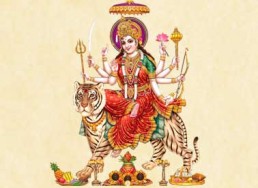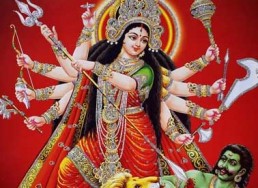Argala Stotram
Argala Stotram Introduction
The Argala Stotram is a powerful hymn dedicated to Goddess Durga, often recited during the Chandi Path or Durga Saptashati. The stotram is composed of verses that invoke the blessings of the Goddess in her various forms, asking for protection, prosperity, victory, and the removal of obstacles. The word “Argala” refers to a “bolt” or “lock,” and just as a lock needs to be opened to gain access to something valuable, the recitation of the Argala Stotram is believed to unlock the blessings and grace of the Divine Mother.
श्रीमहालक्ष्मीर्देवता, श्रीजगदम्बाप्रीतये सप्तशतीपाठाङ्गत्वेन जपे विनियोगः॥
ॐ नमश्चण्डिकायै॥
मार्कण्डेय उवाच
śrīmahālakṣmīrdevatā, śrījagadambāprītaye saptaśatīpāṭhāṅgatvena jape viniyogaḥ..
oṃ namaścaṇḍikāyai..
mārkaṇḍeya uvāca
दुर्गा क्षमा शिवा धात्री स्वाहा स्वधा नमोऽस्तु ते॥1॥
durgā kṣamā śivā dhātrī svāhā svadhā namo’stu te..1..
जय सर्वगते देवि कालरात्रि नमोऽस्तु ते॥2॥
jaya sarvagate devi kālarātri namo’stu te..2..
रुपं देहि जयं देहि यशो देहि द्विषो जहि॥3॥
rupaṃ dehi jayaṃ dehi yaśo dehi dviṣo jahi..3..
रुपं देहि जयं देहि यशो देहि द्विषो जहि॥4॥
rupaṃ dehi jayaṃ dehi yaśo dehi dviṣo jahi..4..
रुपं देहि जयं देहि यशो देहि द्विषो जहि॥5॥
rupaṃ dehi jayaṃ dehi yaśo dehi dviṣo jahi..5..
रुपं देहि जयं देहि यशो देहि द्विषो जहि॥6॥
rupaṃ dehi jayaṃ dehi yaśo dehi dviṣo jahi..6..
रुपं देहि जयं देहि यशो देहि द्विषो जहि॥7॥
rupaṃ dehi jayaṃ dehi yaśo dehi dviṣo jahi..7..
रुपं देहि जयं देहि यशो देहि द्विषो जहि॥8॥
rupaṃ dehi jayaṃ dehi yaśo dehi dviṣo jahi..8..
रुपं देहि जयं देहि यशो देहि द्विषो जहि॥9॥
rupaṃ dehi jayaṃ dehi yaśo dehi dviṣo jahi..9..
रुपं देहि जयं देहि यशो देहि द्विषो जहि॥10॥
rupaṃ dehi jayaṃ dehi yaśo dehi dviṣo jahi..10..
रुपं देहि जयं देहि यशो देहि द्विषो जहि॥11॥
rupaṃ dehi jayaṃ dehi yaśo dehi dviṣo jahi..11..
रुपं देहि जयं देहि यशो देहि द्विषो जहि॥12॥
rupaṃ dehi jayaṃ dehi yaśo dehi dviṣo jahi..12..
रुपं देहि जयं देहि यशो देहि द्विषो जहि॥13॥
rupaṃ dehi jayaṃ dehi yaśo dehi dviṣo jahi..13..
रुपं देहि जयं देहि यशो देहि द्विषो जहि॥14॥
rupaṃ dehi jayaṃ dehi yaśo dehi dviṣo jahi..14..
रुपं देहि जयं देहि यशो देहि द्विषो जहि॥15॥
rupaṃ dehi jayaṃ dehi yaśo dehi dviṣo jahi..15..
रुपं देहि जयं देहि यशो देहि द्विषो जहि॥16॥
rupaṃ dehi jayaṃ dehi yaśo dehi dviṣo jahi..16..
रुपं देहि जयं देहि यशो देहि द्विषो जहि॥17॥
rupaṃ dehi jayaṃ dehi yaśo dehi dviṣo jahi..17..
रुपं देहि जयं देहि यशो देहि द्विषो जहि॥18॥
rupaṃ dehi jayaṃ dehi yaśo dehi dviṣo jahi..18..
रुपं देहि जयं देहि यशो देहि द्विषो जहि॥19॥
rupaṃ dehi jayaṃ dehi yaśo dehi dviṣo jahi..19..
रुपं देहि जयं देहि यशो देहि द्विषो जहि॥20॥
rupaṃ dehi jayaṃ dehi yaśo dehi dviṣo jahi..20..
रुपं देहि जयं देहि यशो देहि द्विषो जहि॥21॥
rupaṃ dehi jayaṃ dehi yaśo dehi dviṣo jahi..21..
रुपं देहि जयं देहि यशो देहि द्विषो जहि॥22॥
rupaṃ dehi jayaṃ dehi yaśo dehi dviṣo jahi..22..
रुपं देहि जयं देहि यशो देहि द्विषो जहि॥23॥
rupaṃ dehi jayaṃ dehi yaśo dehi dviṣo jahi..23..
तारिणीं दुर्गसंसारसागरस्य कुलोद्भवाम्॥24॥
tāriṇīṃ durgasaṃsārasāgarasya kulodbhavām..24..
स तु सप्तशतीसंख्यावरमाप्नोति सम्पदाम्॥25॥
॥ इति देव्या अर्गलास्तोत्रं सम्पूर्णम् ॥
sa tu saptaśatīsaṃkhyāvaramāpnoti sampadām..25..
.. iti devyā argalāstotraṃ sampūrṇam ..

Description
Argala Stotram – Introduction
The Argala Stotram is a powerful hymn dedicated to Goddess Durga, often recited during the Chandi Path or Durga Saptashati. The stotram is composed of verses that invoke the blessings of the Goddess in her various forms, asking for protection, prosperity, victory, and the removal of obstacles. The word “Argala” refers to a “bolt” or “lock,” and just as a lock needs to be opened to gain access to something valuable, the recitation of the Argala Stotram is believed to unlock the blessings and grace of the Divine Mother.
Historical and Scriptural Context:
The Argala Stotram is a part of the Durga Saptashati, a major Hindu text within the Markandeya Purana that narrates the stories of the Goddess Durga’s battles with various demons. These stories symbolize the triumph of good over evil and the cosmic struggle between dharma (righteousness) and adharma (unrighteousness). The Durga Saptashati contains 700 verses, and the Argala Stotram serves as a prelude or introduction to this sacred text. Reciting the Argala Stotram before embarking on the Durga Saptashati is said to enhance the spiritual benefits and efficacy of the ritual.
Structure and Meaning of the Stotram:
The Argala Stotram consists verses where each verse is a prayer asking the Goddess for specific boons or blessings. The refrain “rupaṃ dehi, jayaṃ dehi, yaśo dehi, dviṣo jahi” repeats throughout the stotram, emphasizing the devotee’s desire for beauty (inner), victory, fame, and the destruction of enemies.
Key Themes and Symbolism:
Victory Over Evil:
Throughout the stotram, the Goddess is praised for her past victories over various demons such as Mahishasura, Shumbha-Nishumbha, Raktabīja, and others. These demons represent the internal and external enemies of human life: ego, ignorance, greed, lust, and hatred. The stotram highlights how Durga’s divine intervention is necessary to defeat these enemies and restore order.
Protection and Guidance:
The Argala Stotram frequently asks the Goddess for protection from dangers and enemies. The devotee turns to Durga not only for protection from physical harm but also from mental and spiritual obstacles. The invocation of the Goddess as a protector and savior is central to the stotram, making it a powerful recitation for those seeking shelter from life’s difficulties.
Fame, Fortune, and Prosperity:
In several verses, the devotee prays for wealth, prosperity, health, and fame. The idea here is not only material wealth but also spiritual wealth—inner contentment and peace. The devotee asks for good fortune (saubhāgya), health (ārogya), and success (jaya), recognizing that these are blessings that come from the grace of the Divine Mother.
Removal of Obstacles and Enemies:
The destruction of enemies, both external and internal, is a recurring prayer in the Argala Stotram. The enemies are not just human foes but are symbolic of negative qualities such as doubt, fear, jealousy, and hatred. By destroying these “enemies,” the Goddess paves the way for the devotee’s spiritual and material success.
Devotion and Surrender:
The stotram reflects a deep sense of surrender to the Goddess. It acknowledges that all achievements, blessings, and victories are due to her grace. The repeated invocation of her power highlights the devotee’s faith in her ability to transform their life.
Grace of the Goddess:
Many verses of the Argala Stotram describe the Goddess as Bhagavati, the supreme divine mother, and Jagadamba, the mother of the universe. She is depicted as the all-pervading force in the universe, who both protects and nurtures. The stotram emphasizes that the Goddess’s grace can bestow auspiciousness, happiness, and fulfillment to those who worship her with devotion.
Other Durga Shlokams
Ayigiri Nandini
The Mahishasura Mardini Stotram also known popularly as Aigiri Nandini, holds immense significance during Navratri. The word Mahisha means buffalo and Asura means Rakshasa or Demon. Composed by the great sage Adi Shankaracharya around 810 AD, this…
Devi Aparadha Kshamapana Stotram
Composed by Sri Adi Shankaracharya. Aparadha Kshamapana stotram is usually recited after a recital or after the completion of Puja. Its like asking for forgiveness from Goddess for various mistakes th
Devi Suktam
Devi Suktam or the Vaak Sutam (Vak suktam) occurs in the 10th mandala of Rig Veda Samhita as suktam number 125. The seer of the mantra is vak, the daughter of rishi ambharnaa,
Durga Suktam
This is a prayer to the fire god Agni occurring in the Maha Narayana Upanishad. Section two. Agni, the Lord of Fire, symbolises the power of action.Goddess Durga symbolizes dynamism, energy, diligence
Kalika Ashtakam
Composed by Sri Adi Shankaracharya on devi Kalika. The Goddess Kali is the guardian, also known as Kalika. The protectors, the Mother, Kali is Dharma and eternal time. Kali shines with the brilliance
Keelaka Stotram
Rishi Markandeya tells his disciples in sixteen shlokas the ways and means of removing obstacles faced by devotees while reading Devi Mahatmya. Reading of Keelakam brings blessings of Devi, spiritual
Mahishasura Mardini Storam
Mahishasura Mardini Stotram - This is a prayer to the Goddess who killed Mahishasura. “The place where Sri Mahishasura Mardini Stotram is sung every day, I will always be present and never leave.” - The Devi’s proclamation in the 12th chapter of the…
Sarva Mangala Mangalye
Sarva Mangala Mangalye - Salutations to you O Narayani, who is the auspiciousness of all that is auspicious, the consort of Lord Shiva, who is the means of accomplishing all desires, and who is the refuge of all, the consort of the three eyed Shiva,…
Shakradaya Stuti
This famous stuti is sung by Shakra (Indra) and the other devas in praise of Durga. This is part of Chandi path which is a text about Goddess Chandi. It is also called Durga Saptashati or 700 verses r
Tantrokta Ratri Suktam
Ratri Sukta is one of the famous hymn to Goddess Durga. This in true essence praises the latent energy in Narayana and in every sadhak. Ratri Suktam is used to invoke that energy and to enhance the mi
Argala Stotram – Durga – Lyrics In Sanskrit, English Translation, Meaning, Significance and Audio.


